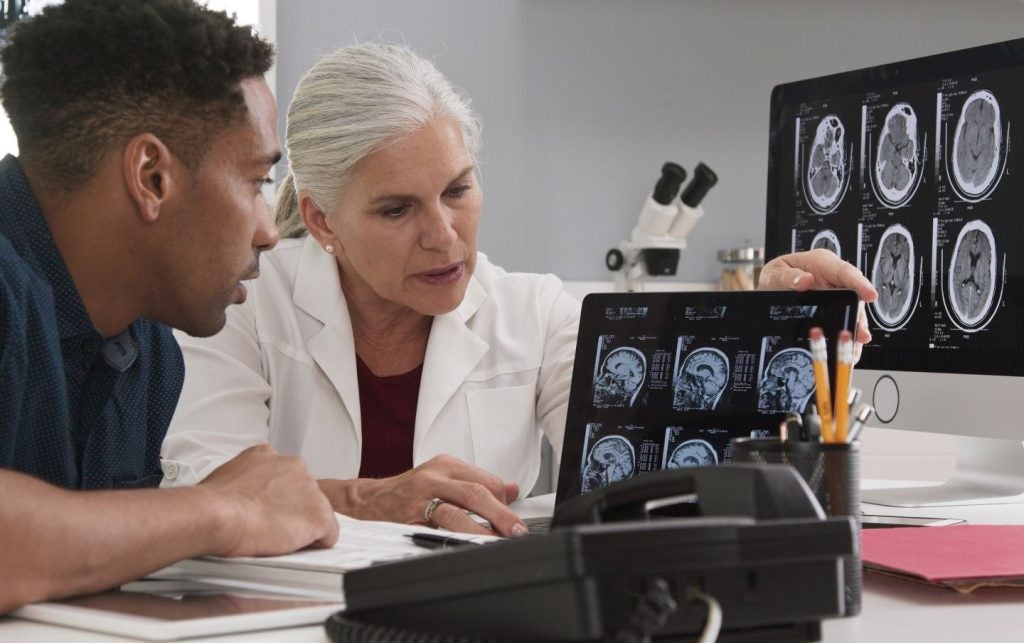The top trends are the most mentioned terms or concepts among healthtech Twitter discussions of more than 150 healthcare experts tracked by GlobalData’s Healthcare Influencer platform during the third quarter (Q3) of 2021.
1. Digital Health and Mhealth (mobile health) – 3,781 mentions
A sensor-embedded patch developed by engineers from the Massachusetts Institute of Technology (MIT), medical imaging company Nanox announcing two acquisitions, and software applications being used to treat health issues were some of the most popular discussions on digital health in Q3 2021.
Eric Pilkington, senior partner and managing director at technology company IBM, shared an article on a sensor-embedded adhesive patch developed by MIT engineers and researchers from South Korea. The flexible patch is akin to electronic skin and can track a person’s health without failing even when the person is sweating. The patch features artificial sweat ducts engraved through the material’s ultrathin layers, which are arranged in a pattern similar to the pores in human skin. The artificial sweat ducts allow sweat to be released from the patch preventing skin irritation and damage to the implanted sensors.
Digital health was also discussed in a tweet by John Nosta, president of technology company NostaLab, on Nanox’s plans to acquire computer vision start-up Zebra Medical Vision and teleradiology company USARAD and a related company named Medical Diagnostics Web (MDW). Nanox aims to provide end-to-end medical imaging solutions through the acquisitions. The company plans to create a network of radiologists and provide them with artificial intelligence (AI)-based algorithms, which will enable the rapid interpretation of medical images.
In another tweet, Daniel Kraft, chair of the XPRIZE Pandemic Alliance Task Force comprising universities and non-government organisations focused on developing medical solutions, shared an article on software applications being used to treat health issues such as insomnia. Non-profit trade association, the Digital Therapeutics Alliance claims that software can be used to prevent, treat and manage a variety of health problems.
How well do you really know your competitors?
Access the most comprehensive Company Profiles on the market, powered by GlobalData. Save hours of research. Gain competitive edge.

Thank you!
Your download email will arrive shortly
Not ready to buy yet? Download a free sample
We are confident about the unique quality of our Company Profiles. However, we want you to make the most beneficial decision for your business, so we offer a free sample that you can download by submitting the below form
By GlobalDataDigital healthcare portal Big Health’s mobile apps Daylight and Sleepio, for example, help in treating anxiety and insomnia. The two apps have been demonstrated to be useful based on data from 13 randomised controlled trials involving 13,000 participants, the article detailed. The Digital Therapeutics Alliance plans to use the data to convince the government to establish legislation that will recognise apps related to a medical device or digital therapeutics and bring them under insurance coverage.
MIT engineers & researchers have developed a sweat-proof “electronic skin” — a conformable, sensor-embedded sticky patch that monitors a person’s health without malfunctioning or peeling away, even when a wearer is perspiring. #DigitalHealth #WearableTech https://t.co/BD6EuQ16LE
— epilkington (@epilkington) July 7, 2021
2. Coronavirus Disease 2019 – 994 mentions
The lack of data on new Covid-19 infections posing a risk to Americans, deep learning being used to discover drug combinations for treating Covid-19, and an AI tool used to predict Covid-19 patients’ oxygen needs were some of the trending discussions in Q3.
Eric Topol, a physician and scientist, shared his article on the US Centers for Disease Control and Prevention’s (CDC) plans to stop tracking post-vaccination Covid-19 infections or breakthrough infections. Topol noted that the move will not provide the required data to deal with the fourth wave of infections and added that it could generate a false sense of security and complacency among people leading to negligence in taking preventive measures such as wearing masks and social distancing.
Topol stated that the first step to preventing the disease is to collect relevant data including the vaccination status of people with a breakthrough infection who have been admitted to the hospital with Covid-19. In addition, parameters such as age, time since immunisation, the vaccine used, and co-existing medical problems of such patients should be tracked. The CDC’s failure to track this data could put vaccinated Americans at risk and leave the country without an appropriate plan to deal with the Delta wave, he added.
Brian Ahier, lead health IT engineer at not-for-profit corporation MITRE, shared an article on deep learning being used to discover synergistic drug combinations for treating Covid-19. Lack of adequate training data on drug combinations is currently a hindrance for existing machine learning models to accurately analyse novel drug combinations. A study was conducted on a deep learning architecture named ComboNet, which can predict synergistic medicine combinations by modelling both chemical structure and biological targets. ComboNet was used to screen 11,600 drug combinations, 30 of which combinations were tested. The study found two medication combinations to have high synergy in vitro among the analysed combinations including remdesivir and reserpine.
In another tweet, Dr. Bertalan Mesko, director of The Medical Futurist, an institute exploring the use of digital technology in healthcare, shared an article on an AI tool being used to predict the oxygen needs of Covid-19 patients. Research conducted by the Addenbrooke’s Hospital in Cambridge, UK and healthcare technology company NVIDIA analysed chest X-rays and electronic health data of 10,000 Covid-19 patients using an AI tool named EXAM to predict their oxygen needs. The AI tool was able to predict the oxygen requirements of patients within 24 hours of their arrival in the emergency unit, with a sensitivity of 95% and an accuracy of more than 88%, the article detailed.
There are >80,000 hospitalized covid patients in the US today.
We need to know vaccination status, time from vaccine, which vaccine, age, comorbidities, at a minimum.
Every day. Posted for all.
All these data are captured in EHRs, just not aggregated.https://t.co/X12xZmWghb— Eric Topol (@EricTopol) August 13, 2021
3. Artificial Intelligence (AI) – 791 mentions
The different ways in which AI is revolutionising the healthcare sector, AI being used to convert brain waves into text, and the US Food and Drug Administration (FDA) authorising the first AI-based software to detect prostate cancer were some of the trending discussions on AI in Q3.
Ian Jones, a publisher and content curator, shared an article on how AI is revolutionising the healthcare industry. The technology, for example, can be used to provide virtual assistance in healthcare, conduct research and advanced analytics, and assist in diagnostics, medical imaging, and drug creation. Mobile app development companies, for example, are using platforms developed by technology companies Google, Microsoft, Apple, IBM, and Amazon to develop apps that can aid medical institutions globally. All the apps include voice assistants, which enable users to receive medication-related notifications and educational materials. Similarly, AI-enabled chatbots are being used to address patient concerns and schedule follow-ups if necessary.
In another tweet, Glen Gilmore, principal of consulting and digital marketing firm the Gilmore Business Network, shared an article on how AI is being used to convert brain waves into text. Researchers from the University of California developed an AI-based solution that analysed a disabled man’s brain waves and converted them into text, allowing him to speak with others. The research can help experts to restore communication by utilising the natural speech system of the human brain, the article detailed.
AI was also mentioned in a discussion about the FDA authorising the first AI-based software to detect prostate cancer. The news was reported in an article shared by Rafael Grossmann, a surgeon and healthcare futurist. Developed by technology company Paige.AI, the tool is called Paige Prostate, which can demonstrate areas with the highest risk of possessing cancer that can be further investigated by pathologists.
The approval was based on data from 16 pathologists who reviewed more than 500 prostate biopsy slides. Pathologists reviewed each image with and without Paige Prostate. The data showed that interpretations assisted by Paige Prostate increased cancer detection by 7.3% while having no effect on evaluating benign slides. The FDA stated that the tool can be used as a supplement to prevent misleading negative and positive results.
How AI is revolutionising healthcare: 10 use cases v/@InformationAge cc @Nicochan33 @BetaMoroney @DrJDrooghaag @FrRonconi @enilev @ramonvidall @RagusoSergio @MikeNashTech @FmFrancoise @louiseoconor @TheAdityaPatro @tobiaskintzel @jeancayeux @baski_LA https://t.co/nuOjDxdZZ5
— Ian Jones (@IanLJones98) September 30, 2021
4. Machine Learning – 259 mentions
The use of machine learning (ML) to detect hidden tumour cells in the human body, AI analytics company Jvion’s ML-based Behavioral Health Vulnerability Map, and the role of ML in population and public health were some of the popularly discussed topics in the third quarter.
Dr. Bertalan Mesko shared an article on research conducted at the Eindhoven University of Technology using machine learning and immunotherapy to detect hidden tumour cells in the human body. The researchers used computational algorithms and datasets from earlier clinical patient care to examine tumour samples and check whether they can predict if a patient will respond to immune checkpoint blockers (ICB). The ML model was found to outperform traditional biomarkers used in clinical settings to evaluate ICB therapies. The research also found that immunotherapy treatment with ICB can be tailored to a patient’s specific needs.
ML was also mentioned in a discussion shared by John Lynn, editor and founder of healthcare IT blog HealthcareScene.com, on Jvion releasing the Behavioural Health Vulnerability Map, which shows the risk of behavioural health-related hospitalisations and self-harm incidents in each community. The map can identify vulnerabilities by using Jvion’s clinical AI to analyse hundreds of publicly available data points and show them on maps provided by Microsoft’s Azure cloud platform. The company has been able to assess more than 10% of the US population using supervised and unsupervised ML. The map can help public health officials and policy change advocates to understand the health conditions prevalent in a particular region, the article highlighted.
In another tweet, software engineer Adrian Adewunmi shared an article on the role of ML in population and public health. ML can be used to identify factors and their relationships with health outcomes, design group-based intervention programmes and predict outcomes such as mortality risks. The technology can also be used to ensure effective resource allocation for various healthcare and public health programmes. Privacy of health data, measuring and integrating social determinants of health, and health disparities are some of the challenges facing ML use in public health settings, according to the article.
Now, researchers at the Eindhoven University of Technology report they have combined machine learning with immunotherapy to find hidden tumors cells in the human body. #geneticengineering #genetics #digitalhealth #future #machine #artificialintelligence
👉 https://t.co/z8pLheiGPr pic.twitter.com/9jfeJUL0ar— Berci Meskó, MD, PhD (@Berci) July 2, 2021
5. Wearables – 243 mentions
Rockley Photonics’ new smartwatch system, health features in Apple Watch Series 7 models, and Whoop new 4.0 fitness tracker were some of the popular discussions on wearables in Q3.
Daniel Kraft shared an article on photonics chipset developer Rockley Photonics’ new wearable smartwatch system featuring high-tech sensors that continually measure a variety of biomarkers such as blood pressure and glucose levels from the wearer’s arm. The wearable can upload the data to a smartphone app for additional analysis using Rockley’s ML-based techniques. The system is equipped with advanced sensors and infrared spectrophotometers. The sensors are packed on a single silicon chip that can scan deeper into the body and pick up indicators previously assessed exclusively by specialist medical equipment.
In another tweet, Gary Monk, healthcare innovation consultant at Gary Monk Digital Consulting, shared an article detailing the health features found in Apple Watch Series 7 models. The smartwatch features include fall detection algorithms, which have been enhanced to recognise the impact of falls that happen during cycling and other exercises. The updated algorithm can recognise when users are riding powered bikes rather than utilising leg power alone. In addition, users will be able to stay motivated during aerobic exercises with its new voice feedback function that will automatically notify workout milestones.
Another discussion on wearables was about wearable company Whoop launching its new 4.0 fitness tracker as mentioned in an article shared by Rafael Grossmann. The compact and subtly designed tracker is meant solely for data collection and neither features a screen nor controls. Aimed at fitness enthusiasts, the tracker, however, features unique characteristics such as measuring how well someone is recovering from their activities and the amount of strain they can endure.
A #DigitalHealth lab on your wrist?
If @RockleyPhotonic can pull it off, the ability to accurately measure continuous glucose, BP, core temp, hydration, muscle lactate, alcohol etc –via a #wearable clinical-grade spectroscopy will be a game-changerhttps://t.co/B7F7AoK0uE
— Daniel Kraft, MD (@daniel_kraft) July 17, 2021








Related Company Profiles
Apple Inc
Microsoft Corp
NVIDIA Corp
Whoop Inc